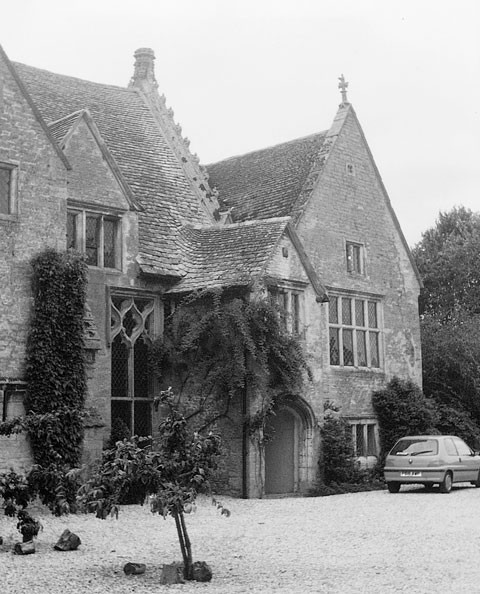
Northborough Manor, County of Cambridgeshire, England, built beginning ca. 1333. James Claypoole (1532/34–1599), grandfather of James Claypoole, (1634–1687) who came to Philadelphia in 1683, purchased the manor in 1572. The younger James was born in this house in 1634. (Photo, Brian Davies.)
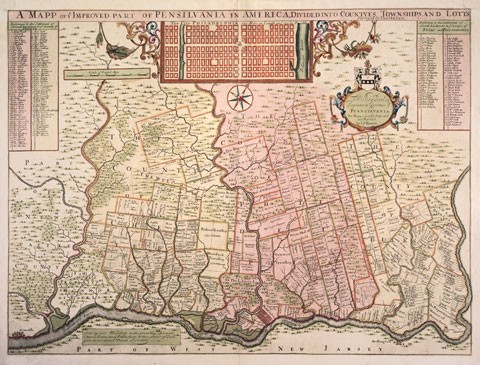
Thomas Holme (1624–1695), A Mapp of Ye Improved Part of Pensilvania in America, London, ca. 1700. Hand colored engraving. 12 1/8" x 18". (Private collection; photo, Lynne Rosenthal.) James Claypoole’s land appears on this early map to the left of the tract designated “German Township.” His eldest son John, who worked as an assistant to Thomas Holme, likely played a part in its creation. The engraving is by George Willdey.
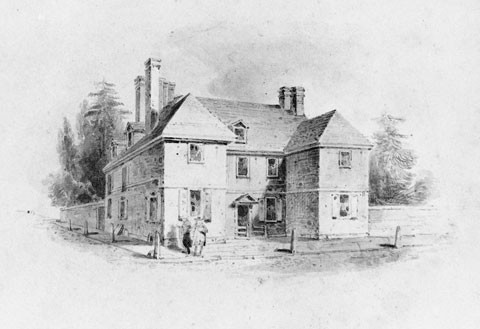
Samuel Carpenter’s Mansion, attributed to George Strickland, Philadelphia, Pennsylvania, 1825–1845. Ink wash on card. 5 5/8" x 7 1/8". (Private collection; photo, Schwarz Gallery, Philadelphia.) During his second trip to Pennsylvania, William Penn resided in Carpenter’s home (built ca. 1687– 1699). Carpenter’s house was located near James Claypoole’s residence on Second Street, but the former did not begin construction until shortly after the latter’s death.

Fall-front desk signed by Edward Evans, Philadelphia, Pennsylvania, 1707. Walnut with white cedar and white pine. H. 66 1/2", W. 44 1/2", D. 19 7/8". (Courtesy, Colonial Williamsburg Foundation.) This desk is the earliest signed and dated piece of furniture from Pennsylvania.
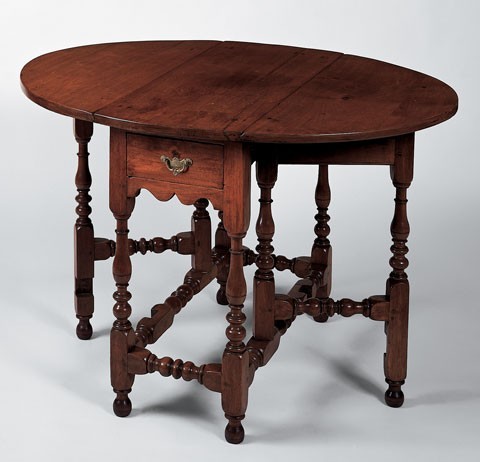
Oval table, Philadelphia, Pennsylvania, 1700–1730. Walnut with tulip poplar and white cedar. H. 29", W. 43 1/4" (open). (Courtesy, National Society of the Colonial Dames of America in the Commonwealth of Pennsylvania at Stenton.) James Logan also purchased oval tables from Edward Evans (1714/15), John Widdowfield (1717), and Thomas Staplefoot (1717). This example, which reputedly belonged to Logan, may represent the work of Joseph Claypoole or one of the aforementioned artisans.
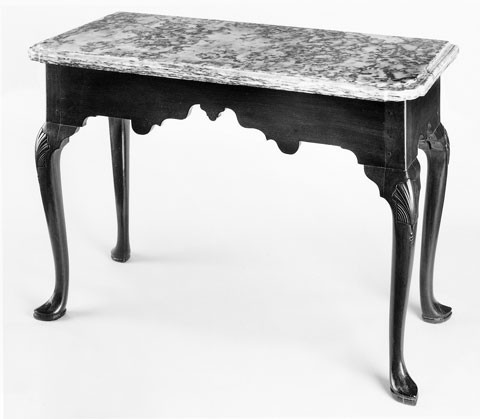
Side table, American, Philadelphia, Pennsylvania, maker unknown, 1740–1760. Mahogany; tulip poplar secondary wood; marble. Base: H. 28 7/8", W. 43", D. 18 1/2". Marble top: H. 1 3/8", W. 44 3/4", D. 21 1/2". (Courtesy, The Baltimore Museum of Art, bequest of J. Gilman D’Arcy Paul, BMA 1972.27.8; photo, Gavin Ashworth.) This example probably resembles the “sideboards” and “frames for marble” that Josiah Claypoole advertised between 1738 and 1740. Presumably, he learned to make such tables in Joseph’s shop.
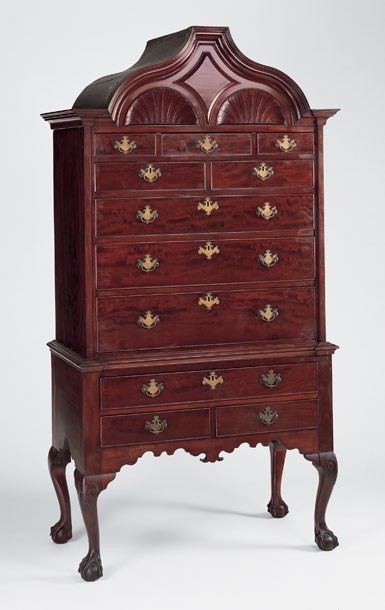
High chest signed by Joseph Claypoole, Philadelphia, Pennsylvania, 1743. Mahogany with maple, tulip poplar, white cedar, and yellow pine. H. 84 1/8", W. 44 1/8", D. 23 1/4". (Courtesy, Philadelphia Museum of Art, gift of Martin A. Battestin.) This is a unique example of an ogee head on a high chest of drawers.
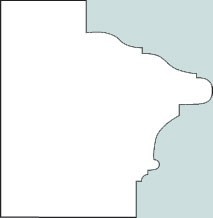
Drawing showing the molding profiles of the high chest illustrated in fig. 7.
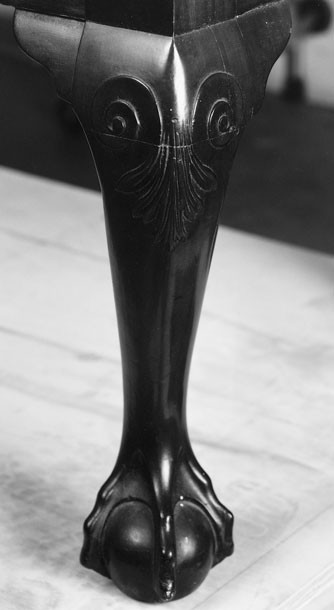
Detail of the left front leg and foot of the high chest illustrated in fig. 7. The naturalistic design and assured carving suggests that Joseph Claypoole’s shop produced claw-and-ball feet before 1743.
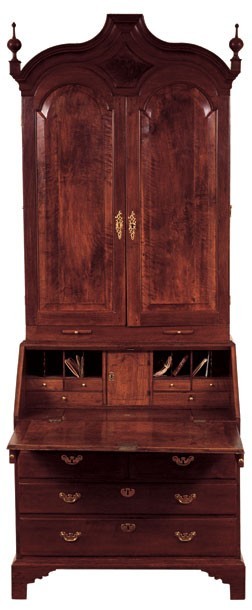
Desk-and-bookcase, Philadelphia, Pennsylvania, 1730–1745. Mahogany with cedar, oak, and tulip poplar. H. 98", W. 38 3/4", D. 22 3/4". (Courtesy, Wyck Association; photo, Eric Mitchell.) This desk has a history of descent in the Wistar family. Probable candidates for its maker are Joseph Claypoole or George Claypoole, Sr.

Desk-and-bookcase, Philadelphia, Pennsylvania, 1730–1745. Mahogany with maple, oak, pine, and tulip poplar. H. 96", W. 40", D. 24 1/4". (Courtesy, Tryon Palace Historic Sites and Gardens, New Bern, North Carolina.)
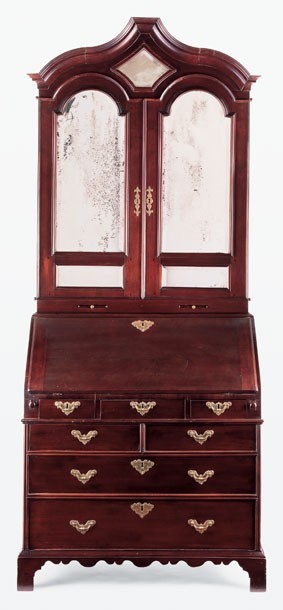
Desk-and-bookcase attributed to Stephen Armitt, Philadelphia, Pennsylvania, 1725–1740. Mahogany and exotic hardwoods with cedar, oak, and tulip poplar. H. 94", W. 34 3/4", D. 22". (Courtesy, National Society of the Colonial Dames of America in the Commonwealth of Pennsylvania at Stenton.)

Stenton, Germantown, Pennsylvania, built 1727–1730. (Courtesy, National Society of the Colonial Dames of America in the Commonwealth of Pennsylvania at Stenton.)
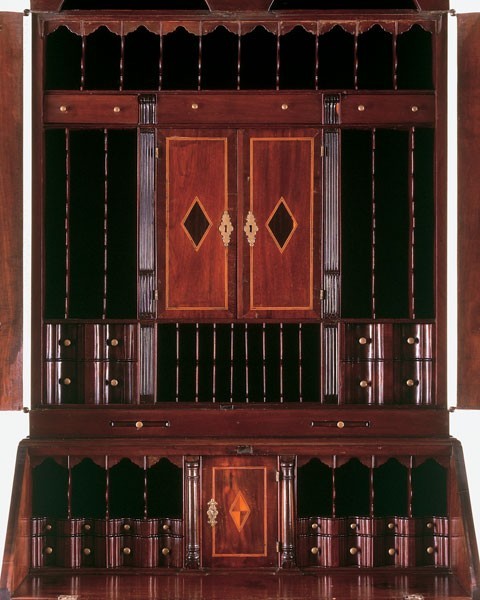
Detail of the interior of the desk-and-bookcase illustrated in fig. 12.

Desk-and-bookcase, Philadelphia, Pennsylvania, 1730–1745. Mahogany with yellow pine and tulip poplar. H. 89", W. 41 1/8", D. 24 3/4". (Private collection; photo, Philadelphia Museum of Art.)
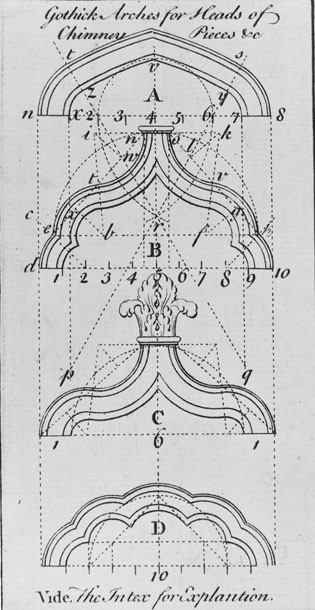
Pediment designs illustrated on p. 186 in Batty and Thomas Langley’s The Builder’s Jewell, or Youth’s Instructor (1741). Architectural engravings may have inspired the pediment designs used by the Claypooles and their contemporaries.
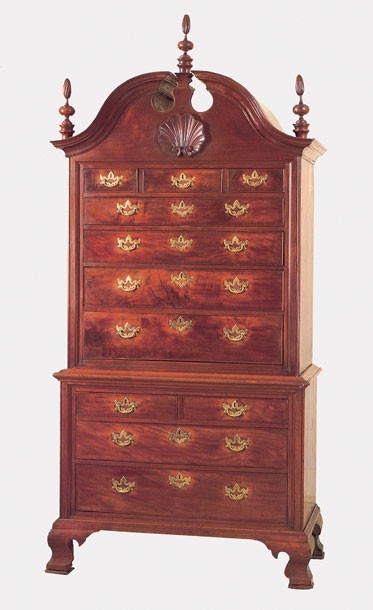
Chest-on-chest, Philadelphia, Pennsylvania, 1730–1745. Mahogany with unrecorded secondary woods. H. 95", W. 44", D. 23 1/2". (Private collection; photo, Christie’s.)

Desk-and-bookcase, London, 1720–1730. Oak with pine; japanned decoration. (Courtesy, Metropolitan Museum of Art, gift of James DeLancey Verplanck and John Bayard Rodgers Verplanck.)
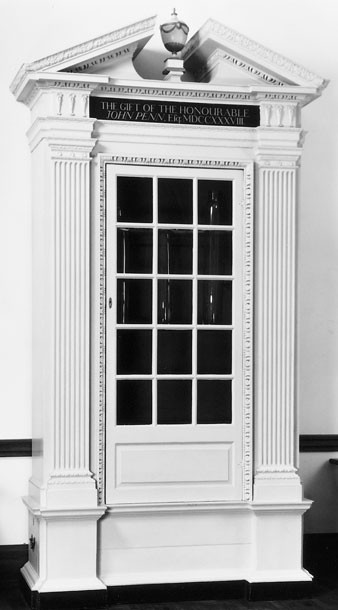
Case for an air pump by John Harrison, Philadelphia, Pennsylvania, 1739. White pine; painted. H. 130 1/2", W. 71 1/4", D. 20 1/4". (Courtesy, Library Company of Philadelphia.) Josiah Claypoole advertised desk-and-bookcases with “Peidment” heads in 1739/40.
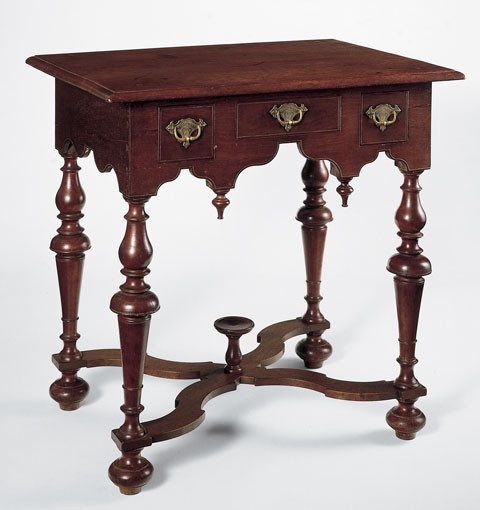
Dressing table, Philadelphia, Pennsylvania, 1715–1725. Walnut with white cedar and yellow pine. H. 29 3/4", W. 33 3/8", D. 20 1/8". (Private collection; photo, Gavin Ashworth.)

Dressing table attributed to Joseph Claypoole or George Claypoole, Sr., Philadelphia, 1725–1740. Mahogany and maple with white cedar and yellow pine. H. 30", W. 34", D. 21 1/4". (Courtesy, Israel Sack, Inc.) The two over two drawer arrangement seen here was common during the 1730s.
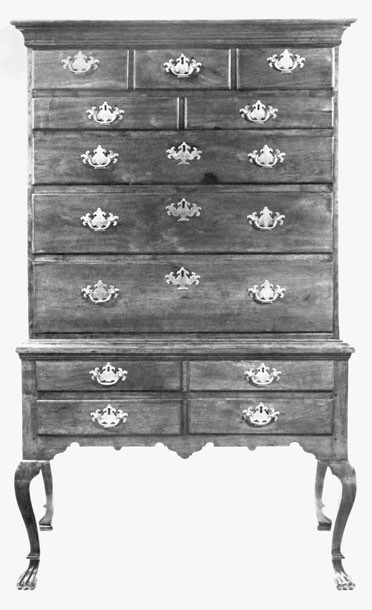
High chest attributed to Joseph Claypoole or George Claypoole, Sr., Philadelphia, Pennsylvania, 1725–1740. Walnut with unrecorded secondary woods. H. 71 1/2", W. 41", D. 21 1/2". (Courtesy, Israel Sack, Inc.)
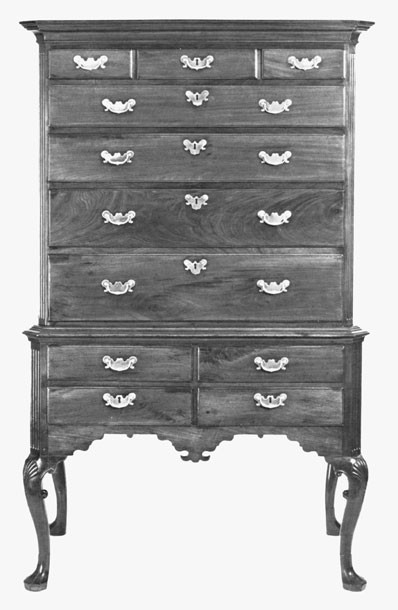
High chest attributed to Joseph Claypoole or George Claypoole, Sr., Philadelphia, Pennsylvania, 1730–1750. Mahogany with unrecorded secondary woods. H. 71 1/2", W. 43 1/2", D. 22 7/8". (Courtesy, Israel Sack, Inc.)

Dressing table attributed to Joseph Claypoole or George Claypoole, Sr., Philadelphia, Pennsylvania, 1725–1740. H. 29", W. 34 1/2", D. 20 1/4". (Private collection; photo, Christie’s.)

High chest attributed to Joseph Claypoole or George Claypoole, Sr., Philadelphia, Pennsylvania, 1740–1750. H. 93", W. 42", D. 22 1/4". (Private collection; photo, Sotheby’s.)
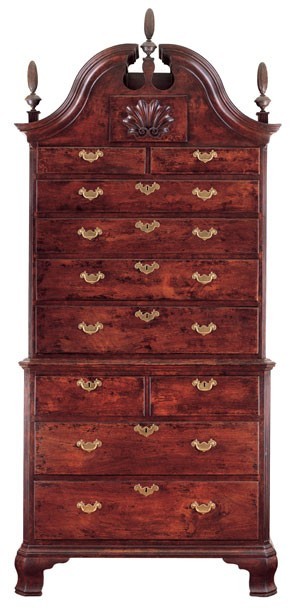
Chest-on-chest signed “Geo. Claypoole, Jr.,” Philadelphia, Pennsylvania, ca. 1754. Walnut with yellow pine and white cedar. H. 97", W. 43 1/4", D. 22 1/2". (Private collection; photo, Gavin Ashworth.) Presumably, George Jr. made this piece shortly after completing his apprenticeship.
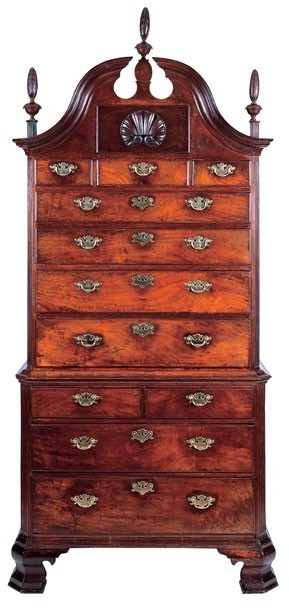
Chest-on-chest, Philadelphia, Pennsylvania, 1740–1750. Walnut with tulip poplar and pine. H. 93", W. 42 1/2", D. 23 1/2". (Private collection; photo, Graydon Wood.)

Detail of the carved shell on the upper drawer of the chest-on-chest illustrated in fig. 26.

Chest of drawers attributed to George Claypoole, Sr. or George Claypoole, Jr., Philadelphia, Pennsylvania, 1755–1770. Walnut with unrecorded secondary woods. H. 31 1/4", W. 36", D. 21". (Courtesy, Israel Sack, Inc.)
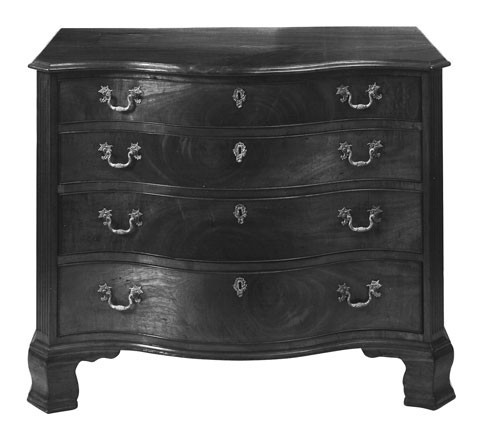
Chest of drawers bearing the label of Jonathan Gostelowe, Philadelphia, Pennsylvania, 1781–1793. Mahogany with tulip poplar, white cedar, and yellow pine. H. 37 1/4", W. 47 1/4", D. 25 1/2". (Courtesy, Cliveden, a National Trust Historic Site.)
